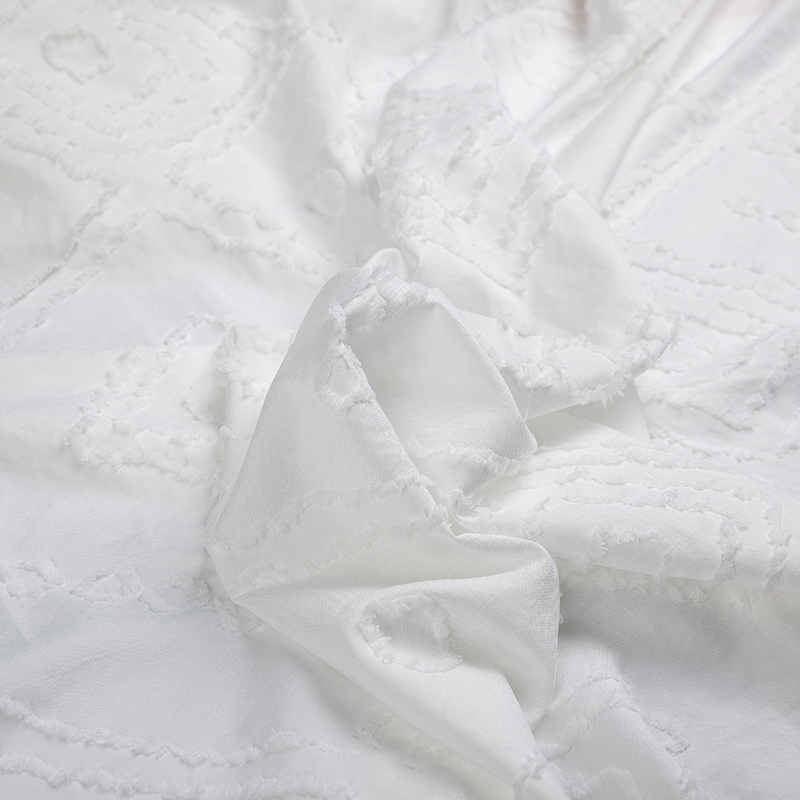Premium quality since 2002!
The "brushing" process, also known as "napping," is a mechanical treatment. Imagine large rollers covered with fine, stiff wires or abrasive surfaces. As the fabric passes over these rollers, the wires gently abrade the surface. This action effectively pulls up tiny, individual fiber ends from the yarns that make up the fabric. It doesn't break the fibers, but rather loosens and lifts them, creating a new, elevated surface layer. The direction and intensity of the brushing can be controlled to achieve different degrees of plushness. For instance, a light brush might give a subtle peach-skin feel, while a heavier brush results in a thick, fleecy texture.
Characteristics and Advantages:
Luxurious Softness: This is the most immediate and noticeable benefit. The lifted fibers create a velvety, skin-friendly surface that feels incredibly soft to the touch. Think of the comforting feel of your favorite flannel pajamas or a soft baby blanket.
Enhanced Warmth and Insulation: The raised fibers create countless tiny air pockets. Air is an excellent insulator, and these trapped air pockets significantly reduce heat transfer away from the body. This is why brushed fabrics like fleece or brushed cotton are mainstays for cold-weather apparel.
Improved Drape: The softened surface can sometimes give the fabric a more fluid and less stiff drape, making it flow nicely over the body.
Reduced Pilling: While some brushed fabrics are treated to reduce pilling, the very nature of brushed fabric makes it more prone to pilling if not treated or if made from certain fiber blends.
Disadvantages:
Pilling Tendency: This is a significant drawback. Because the fibers are loosened and brought to the surface, they are more susceptible to friction. This friction causes the loose fibers to tangle and form small balls or "pills" on the fabric surface, which can make the garment look worn and old. High-quality brushed fabrics often undergo anti-pilling treatments.
Reduced Durability: The brushing process can slightly weaken the individual fibers or the fabric structure at the surface, making it somewhat less resistant to abrasion and tear compared to its unbrushed counterpart.
Moisture Absorption and Drying Time: While excellent for warmth, the trapped air and increased surface area can also mean that brushed fabrics, especially those made from natural fibers, tend to absorb more moisture and take longer to dry. This makes them less ideal for high-intensity activities where rapid moisture wicking is crucial.
Bulkiness: The added loft can make brushed fabrics appear or feel bulkier than smooth fabrics of similar weight.
Common Applications:
Apparel: Flannel shirts, fleece jackets and hoodies, brushed cotton trousers, thermal underwear, pajamas, baby clothes, winter activewear.
Home Textiles: Blankets, throws, bed sheets (flannel sheets), sofa covers.
Non-Brushed Fabric
Process in Detail:
Non-brushed fabrics, by definition, do not undergo the mechanical brushing process. Their surface texture is determined solely by the type of fiber used, the yarn construction (e.g., spun, filament), and the fabric's weave or knit structure. For example, a plain weave cotton will have a crisp, smooth surface, while a satin weave might have a lustrous, sleek feel due to the way the yarns float over each other. The surface remains relatively flat, with fibers tightly integrated into the fabric structure.
Characteristics and Advantages:
Smooth Surface: The defining characteristic is its unadorned, often sleek or crisp surface. The individual yarns and weave/knit pattern are more visible.
Increased Durability and Abrasion Resistance: Without loosened fibers, the fabric surface is more robust and resistant to friction and wear. This makes non-brushed fabrics suitable for garments that need to withstand a lot of stress, like workwear or outdoor gear.
Less Pilling: Since there are no raised fibers to tangle, non-brushed fabrics are significantly less prone to pilling, maintaining a newer appearance for longer.
Better Breathability and Moisture Wicking: With a flatter surface and less trapped air, non-brushed fabrics (especially those engineered for performance like many synthetics) can allow air to circulate more freely and facilitate quicker evaporation of sweat. This is why most athletic wear is non-brushed.
Crisp Hand: Many non-brushed fabrics have a crisp hand, which can be desirable for structured garments like shirts, suits, or certain types of dresses.
Vers
atility in Appearance: From the crispness of poplin to the smooth drape of rayon, non-brushed fabrics offer a vast range of textures and appearances depending on their construction.
Disadvantages:
Less Warmth: Without the insulating air pockets, non-brushed fabrics offer considerably less warmth than brushed fabrics of similar thickness.
Less Softness: While some non-brushed fabrics can be soft (e.g., washed linen, silk), they generally lack the immediate, plush softness of a brushed surface.
Can Feel Cooler: This is a disadvantage if warmth is desired, but an advantage in hot weather.
Common Applications:
Apparel: Dress shirts, denim jeans, t-shirts (most standard cotton tees), activewear (running shirts, gym shorts), summer dresses, suits, blouses, raincoats.
Home Textiles: Bed sheets (percale, sateen), tablecloths, curtains, upholstery.
Key Takeaway: The Trade-off
The choice between brushed and non-brushed fabric is fundamentally a trade-off:
Choose Brushed when: Softness and warmth are the primary goals, and a slightly higher maintenance requirement (due to pilling potential) is acceptable. Think comfort, coziness, and insulation.
Choose Non-Brushed when: Durability, breathability, a smooth aesthetic, and resistance to pilling are paramount. Think performance, structure, and ease of care.
Understanding this distinction helps in selecting the appropriate fabric for a specific garment or textile, aligning its properties with the desired function and aesthetic.


 English
English 简体中文
简体中文









